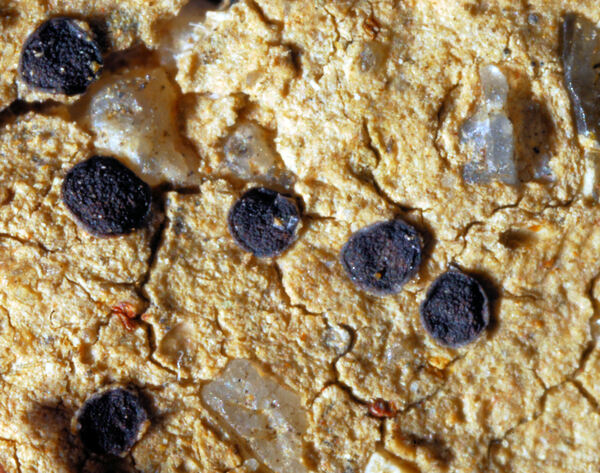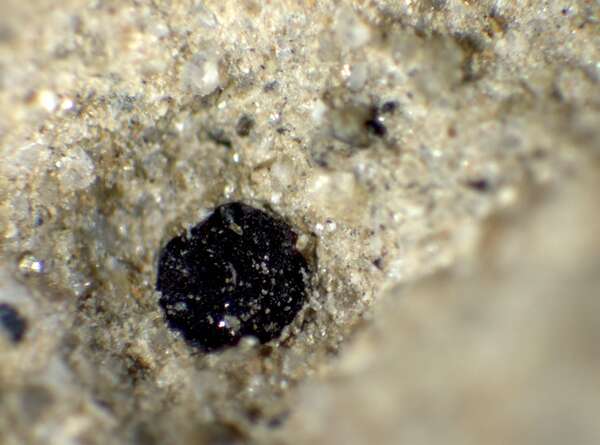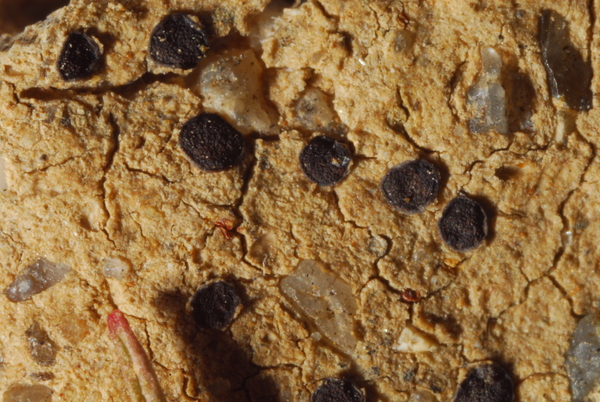Diploschistella athalloides (Nyl.) Lücking, Knudsen & Fryday
in Nash & al., Lichen Flora Gr. Sonoran Desert Reg., 3: 228, 2007. Basionym: Lecidea athalloides Nyl. - Bull. Soc. bot. Fr., 7: 503, 1860.
Synonyms: Diploschistella urceolata Vain.; Gyalidea psammoica (Nyl.) Lettau; Gyalideopsis athalloides (Nyl.) Vězda; Lopadium athalloides (Nyl.) Samp.; Lopadium newtonii Samp.
Distribution: S - Cal (Puntillo 1996, Puntillo & Puntillo 2004).
Description: Thallus crustose, very thin, dirty white to ochre-coloured, granulose to film-like, poorly delimited, hardly visible when dry except around the apothecia, gelatinous when wet. Phenocortex inconspicuous, prosoplectenchymatous, becoming gelatinized around soil particles. Apothecia zeorine, orbicular to slightly irregular, 0.5-1.5 mm across, at first immersed-erumpent, then sometimes almost sessile, with a flat to slightly convex, dull blackish disc turning brown when moist, a concolorous proper margin and a raised, irregular, lacerated, sometimes evanescent thalline margin. Proper exciple dark brown to almost black, subparaplectenchymatous but the cell lumina indistinct in water; epithecium dark brown, <10 µm high; hymenium pale brown to pale yellow, 70-100(-120) µm high, I-, K/I-; paraphyses coherent, thin and mostly indistinct; subhymenium hyaline or pale yellow, c. 15 µm high; hypothecium colourless to pale yellow, thin beneath the hymenium, widening and radiating upward into margin. Asci 4-5-spored, clavate, with indistinct tholus and ring-shaped structure protruding down into the lumen, I-, K/I-, 70-80 x 20-25 µm. Ascospores hyaline, submuriform with 8-12 cells, ellipsoid, 25-30(-40) x 15-20 µm. Photobiont chlorococcoid. Spot tests: K-, C-, KC-, P-, UV-. Chemistry: without lichen substances.Note: a species with an ephemeral, thin thallus recalling an algal film, or completely immersed in the uppermost soil layers, with immersed-erumpent apothecia, thin-branched and anastomosing paraphyses, and asci with submuriform ascospores; it grows on acid clay soil in disturbed and periodically dry habitats within open, otherwise very humid forests; widely distributed in both Hemispheres, but with scattered records only.
Growth form: Crustose
Substrata: soil, terricolous mosses, and plant debris
Photobiont: green algae other than Trentepohlia
Reproductive strategy: mainly sexual
Pioneer species
Commonnes-rarity: (info)
Alpine belt: absent
Subalpine belt: absent
Oromediterranean belt: absent
Montane belt: absent
Submediterranean belt: absent
Padanian area: absent
Humid submediterranean belt: extremely rare
Humid mediterranean belt: extremely rare
Dry mediterranean belt: absent

Predictive model
Herbarium samples
Growth form: Crustose
Substrata: soil, terricolous mosses, and plant debris
Photobiont: green algae other than Trentepohlia
Reproductive strategy: mainly sexual
Pioneer species
Commonnes-rarity: (info)
Alpine belt: absent
Subalpine belt: absent
Oromediterranean belt: absent
Montane belt: absent
Submediterranean belt: absent
Padanian area: absent
Humid submediterranean belt: extremely rare
Humid mediterranean belt: extremely rare
Dry mediterranean belt: absent

Predictive model
| Herbarium samples |
 Index Fungorum
Index Fungorum
 GBIF
GBIF





